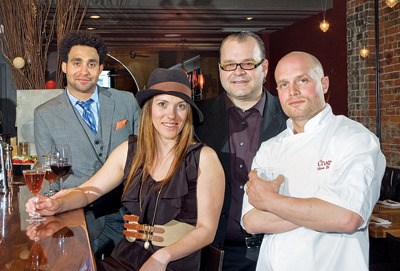A couple of nights ago at a popular downtown restaurant, not long after the guests had gone home in the turbid wake of an excellent Playhouse Wine Festival dinner, I fell into some brandy with a longtime trade colleague.
We discussed, as we often do, the current state of Vancouvers restaurant scene not its day-to-day workings, but rather the big-picture stuff that considers the riddle of variables that, when deciphered, can often point to a manageable route onward and upward.
His big question was easy to ask but difficult to answer: Whats next?
By next my co-drinker wasnt being pleasantly banal. He wasnt curious as to what restaurant was opening next but rather what was coming next in the grander, epochal sense of the word as in which restaurant (existing or still the figment of some 25-year-old line cooks still callow imagination) would give our food scene just the right course correction to keep it away from the rocks of ubiquity and stagnation.
Since neither of us could come up with an immediate answer, it helps to look back.
If we chopped our reputation as a food city down and counted its rings, wed probably get a hard birth date of 1986, back to when John Bishop opened his elegant, eponymous room on the West 4th drag.
Some might take it back even further to when Umberto Menghi launched his first restaurant in 1973, but Bishops was the first of what I would call the alpha feeders.
With its unapologetic attachment to local products and its refined, almost prophetic sense of Vancouvers promise as an ingredient-driven town, it would influence either subtly or strongly just about every new eatery that followed and after 25 years, it continues to be one of only a handful of rooms that defines dining in this city.
How many scene-changers have there been since then? Ive spent the days since asking around and listened to arguments for many.
Gord Martins small plates-pioneering Bin 941 was mentioned several times, as was the casual Feenies on West Broadway and Yaletowns Glowbal which covers a lot of conceptual ground.
Theres no denying that each one (and not a few of their offspring) has been tremendously influential, but does that make them alpha feeders? Im not so sure.
Upscale chains like Earls and Cactus Club which have evolved to become the food equivalents of The Gap and Banana Republic have been even more influential, yet they have hardly been leaders in the larger sense.
People dont leave Earls exclaiming, Now I know why Vancouver is celebrated around the world as a food city!
False Creeks C was also a candidate as a restaurant that has changed the local food scene, and its no mystery why.
Its contributions on the sustainability front have been second to none, and its one of only a pitiful few waterfront restaurants that has exhibited any real interest in exceeding guest expectations.
Instead of resting on the beauty of its idyllic location to become a mediocre venue for special occasions, it has consistently sought to blow us away. In the end, however, it plies its trade on the same road paved by Bishops. As good as it is, it isnt a true alpha feeder.
Until the middle part of the last decade, these restaurants nevertheless ruled Vancouvers roost.
We were inundated with eateries that were clever amalgams of what had made them successful. They kept Evoke, the design team behind Glowbal, very busy (the company has designed over a dozen local restaurants); borrowed Bin 941s tapas, obnoxiously loud soundtrack and industry hangout sensibilities; thanked Feenies for permitting the viewing of Vancouver Canucks hockey in upscale environs; followed the lead of C by giving a damn; and stole whole pages out of the chains robo-service playbook.
It looked as if that was our fate and a perfectly enjoyable fate it would have been until the award-winning Chambar landed on Beatty in late 2004.
Its casual fling with fine dining exuded an irresistible, infectious lack of doubt, and we were smitten as we hadnt been in a very long time. The explosion of our cocktail culture had its fuse lit there.
Our affections for beer found new conjugations in its embrace. It inspired or directly spawned dozens of new restaurants, many of which are owned by former Chambar employees (all of whom are enjoying varying degrees of success).
As for the food, well, I think its safe to say that we never imagined Belgian-Moroccan could be so good.
Without fail, Chambar was cited by every top chef, restaurateur and serial diner that I spoke to this past week as the only restaurant to have truly equalled the hitherto singular achievement of Bishops, and I couldnt agree more.
It is the very definition of an alpha feeder. It changed how we went out for dinner.
Which brings me back to the start, back to my brandy buddys question. Whats next?
Truly, I havent the foggiest idea.
That a restaurant gets its seat reserved in such an exclusive pantheon is only revealed after several years of service long after the reverberations of its impact turn steady to a pleasant note.
For a food wonk like me, its nevertheless an exhilarating thing to ponder.
If its already here, I aim to enjoy finding out.



